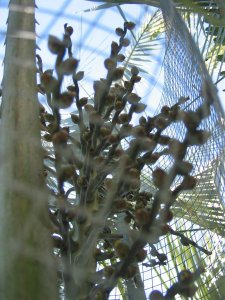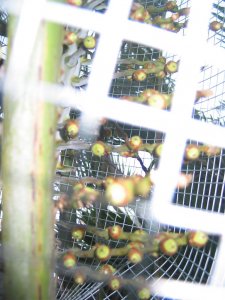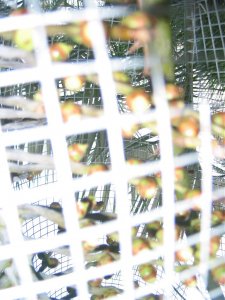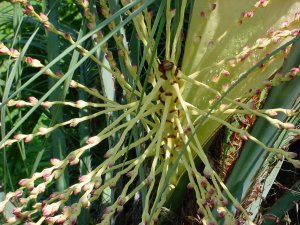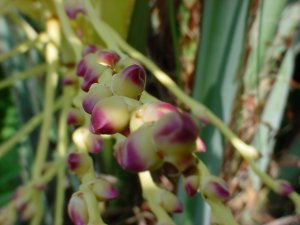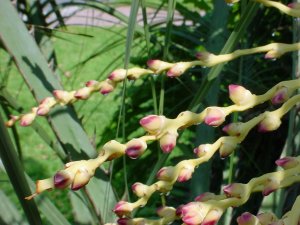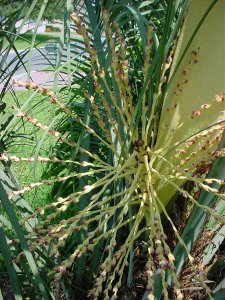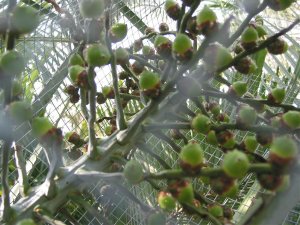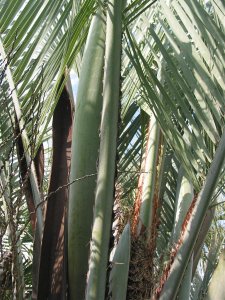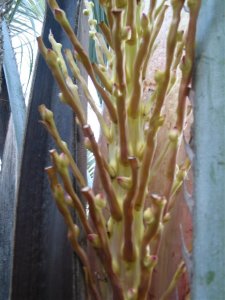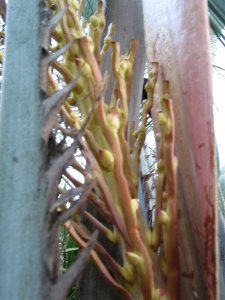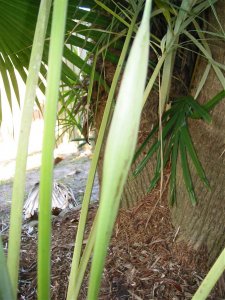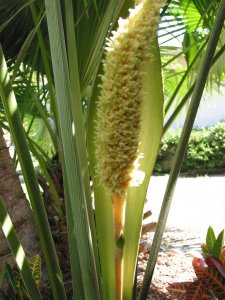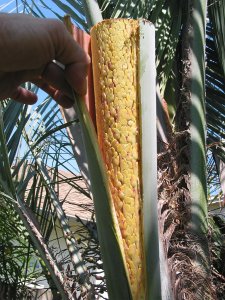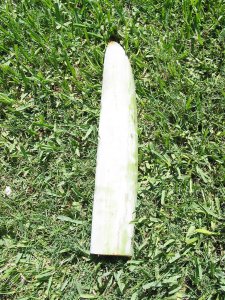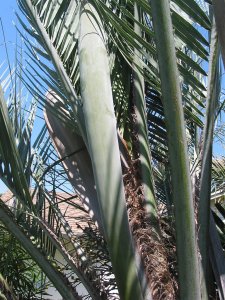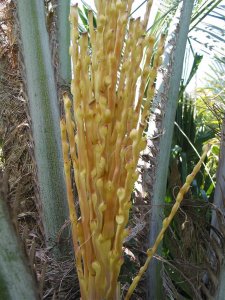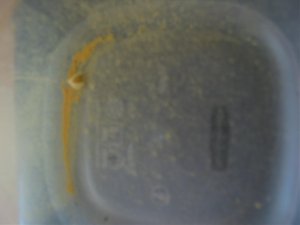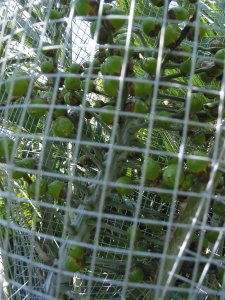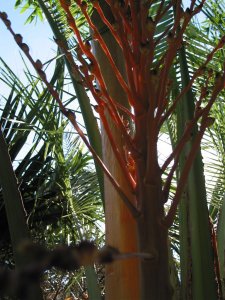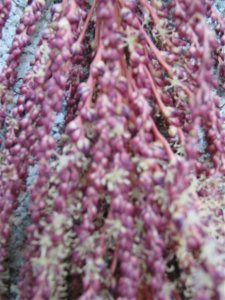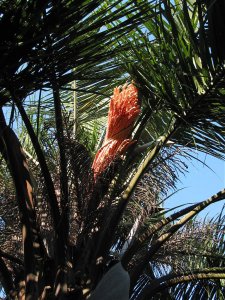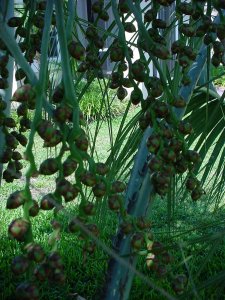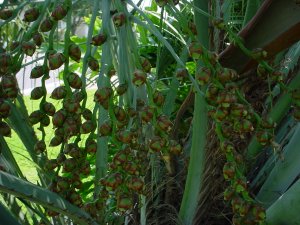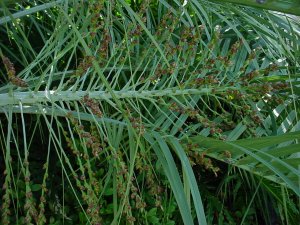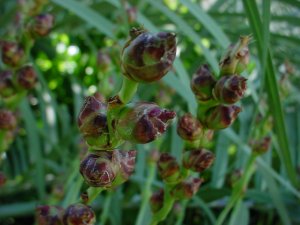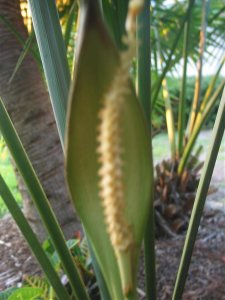You are using an out of date browser. It may not display this or other websites correctly.
You should upgrade or use an alternative browser.
You should upgrade or use an alternative browser.
The making of a Butiagrus
- Thread starter ScotTi
- Start date
crazypalmdude
Member
- 17
- 06/02/11
- 0
- 21
this is awsome thanks! I have a dypsis decaryi that im going to cross with a dypsis leptocheilos , none of them are close to flowering yet but someday...
rpebinger
Active Member
- 80
- 01/10/10
- 0
- 36
Scott,
Thank you again for such a great play-by-play thread. I've got great news - my Butia FINALLY opened its first spathe today. I think you'll see by the pics I post - that I was paying attention
I'll go back through the thread, but after watering the post-neutered female flowers down on day one - does the bag go on or should I wait until the females are about to reach anthesis and multiple washings to bag?
Here's the fruits of my Day 1 labor:
Thank you again for such a great play-by-play thread. I've got great news - my Butia FINALLY opened its first spathe today. I think you'll see by the pics I post - that I was paying attention
I'll go back through the thread, but after watering the post-neutered female flowers down on day one - does the bag go on or should I wait until the females are about to reach anthesis and multiple washings to bag?
Here's the fruits of my Day 1 labor:
Attachments
ScotTi
Esteemed Member
- 4,828
- 16/04/08
- 312
- 163
Rich, Looking good!!!! I bag after washing them down after the removal of male flowers. You will be ok as long as the females have not become receptive. Things should move along faster as the temps have become hot for us now. Should not be hard to find a S.rom in flower, as around here they all seem to be flowering now.
rpebinger
Active Member
- 80
- 01/10/10
- 0
- 36
My prude females took 8 days to reach anthesis Scott - thought they'd never go looking for pollen love. I hit them with a fresh Syagrus r. inflorescense last night and doused them in a nice cloud via shaking.
How quick/drawn-out is the successful pollination? The reason I ask - is that there was a light sprinkle last night. I'm hoping that enough fresh pollen hit the flowers when they were receptive to ensure a decent seed set.
More to follow and thanks again Scott!
Rich
How quick/drawn-out is the successful pollination? The reason I ask - is that there was a light sprinkle last night. I'm hoping that enough fresh pollen hit the flowers when they were receptive to ensure a decent seed set.
More to follow and thanks again Scott!
Rich
ScotTi
Esteemed Member
- 4,828
- 16/04/08
- 312
- 163
Rich, I do not know if the light sprinkle will really effect the outcome. Did you have the Butia flowers covered with the pillowcase? Did you leave the S. rom inflorescence in the pillow case or were you using saved pollen? My next Butia inflorescence should pop any day now, but the Allagoptera looks to be just sitting. I will prepare the Butia inflorescence for the Allagoptera pollen but it just may not happen this go round.
ScotTi
Esteemed Member
- 4,828
- 16/04/08
- 312
- 163
this is awsome thanks! I have a dypsis decaryi that im going to cross with a dypsis leptocheilos , none of them are close to flowering yet but someday...
Patrick, That sounds like a nice cross.
rpebinger
Active Member
- 80
- 01/10/10
- 0
- 36
Rich, I do not know if the light sprinkle will really effect the outcome. Did you have the Butia flowers covered with the pillowcase? Did you leave the S. rom inflorescence in the pillow case or were you using saved pollen? My next Butia inflorescence should pop any day now, but the Allagoptera looks to be just sitting. I will prepare the Butia inflorescence for the Allagoptera pollen but it just may not happen this go round.
Scott,
I didn't have a pillowcase over the Butia flowers - as my cross-contamination risk was very low (closest Butia is about 1/4 mile away and didn't have a freshly opened spathe). I waited until the day I saw the females reach anthesis and harvested a fresh S. rom inflorescence. I shook the heck outta my S rom. inflo and saw a nice cloud right over the female Butias. I've got two more Butia spathes on their way and ready to pop at any moment.
I sure would like to see that Butia x Allogoptera cross work. Keep us posted.
Thanks,
Rich
ScotTi
Esteemed Member
- 4,828
- 16/04/08
- 312
- 163
Rich, I think you will be ok with the cross. The rain may reduce the total seed count, but you will get some. I have 3 more spathes pushing on the Butia and I hope to get the ButiaX Allogoptera out of one of them. I do not know how long the spathe of a Allogoptera take to open as the palm is a slow grower so the flowering may be some time off. I have another Butia that usually will start flowering in June and will continue into July, so I think I will have a few chances at a ButiaXAllogoptera.
- 9,565
- 28/09/07
- 121
- 223
Scott,
I wish I had your patience.
I wish I had your patience.
ScotTi
Esteemed Member
- 4,828
- 16/04/08
- 312
- 163
Scott,
I wish I had your patience.
Patience is waiting for the Allogoptera to flower.
Attachments
rpebinger
Active Member
- 80
- 01/10/10
- 0
- 36
I hate that the timing isn't aligned for you Scott. I am really looking forward to seeing the B x A cross. Have you ever done that to a Butia spathe before (cutting top of it off to try and get it to bloom faster)? Please keep us posted.
Last edited:
ScotTi
Esteemed Member
- 4,828
- 16/04/08
- 312
- 163
I hate that the timing isn't aligned for you Scott. I am really looking forward to seeing the B x A cross. Have you ever done that to a Butia spathe before (cutting top of it off to try and get it to bloom faster)? Please keep us posted.
Rich, I am not giving up on this. This is the cross I have waited a long time to try. The timing may not be perfect, but I am going to give it my best shot. I have never cut the spathe early before, but I think it may work. I waited about an hour to start the male flower removal and a few had already opened. This is going to be a first for me, as I am going to collect and save the Allogoptera pollen for these girls. I left around 100 Butia girls (pic #1) to wait the Allogoptera pollen. This is the Allogoptera polen collected today (pic#2).
Attachments
ScotTi
Esteemed Member
- 4,828
- 16/04/08
- 312
- 163
Rich, Really good news! I checked out my rose/pink flowering Butia and it is in flower. The females were not receptive but it should happen in the next few days. Removed the males and washed the palm down and covered the female flowers. I am feeling better now.
Attachments
rpebinger
Active Member
- 80
- 01/10/10
- 0
- 36
Very nice Scott! I don't have a pic from today - but as you had predicted - the first inflorescence's seed set was 'okay'. I'd say that I've had about 30% seed drop so far. I will try and get a pic for posting in the thread for tomorrow.
I think I waited a bit too long into anthesis to pollinate the females. I was trying to dry out a fresh S. rom for pollen instead of just having one with all its pollen at the ready. I saw the female while flowers (end of anthesis) sprout just as I was dusting with a fresh S rom. inflo. I had a second a Butia inflo that I kept whole with the exception of all the males flowers. I also had a fresh S. rom. loaded with fresh pollen at the height of anthesis. I am expecting a stellar seed set from the full 2nd flower. I'll keep you posted. Thanks for the thread and all the advice - really some great stuff!
I think I waited a bit too long into anthesis to pollinate the females. I was trying to dry out a fresh S. rom for pollen instead of just having one with all its pollen at the ready. I saw the female while flowers (end of anthesis) sprout just as I was dusting with a fresh S rom. inflo. I had a second a Butia inflo that I kept whole with the exception of all the males flowers. I also had a fresh S. rom. loaded with fresh pollen at the height of anthesis. I am expecting a stellar seed set from the full 2nd flower. I'll keep you posted. Thanks for the thread and all the advice - really some great stuff!
rpebinger
Active Member
- 80
- 01/10/10
- 0
- 36
Rich, Really good news! I checked out my rose/pink flowering Butia and it is in flower. The females were not receptive but it should happen in the next few days. Removed the males and washed the palm down and covered the female flowers. I am feeling better now.
With the flower color differentiation - have you or anyone ever given any thought to Butia capitata vs. odorata varietal? Just curious. I was calling everything capitata until someone corrected me that most all of these now odorata....fantastic mommas regardless!
ScotTi
Esteemed Member
- 4,828
- 16/04/08
- 312
- 163
With the flower color differentiation - have you or anyone ever given any thought to Butia capitata vs. odorata varietal? Just curious. I was calling everything capitata until someone corrected me that most all of these now odorata....fantastic mommas regardless!
Rich, The thoughts were given years ago on the ID of this Butia. I heard them all from the real deal "capitata" a "Butia hybrid" to a "hybrid with Jubaea". I just call it a Butia. It may require DNA testing on this one
rpebinger
Active Member
- 80
- 01/10/10
- 0
- 36
ScotTi
Esteemed Member
- 4,828
- 16/04/08
- 312
- 163
Here's a couple of what remains from 1st inflorescence:
View attachment 6684
View attachment 6685
Spathe number two following anthesis and some heavy pollen dusting:
View attachment 6686
View attachment 6687
Thanks,
Rich
Rich, Your seed sets are looking great! You must have a lot of patience as it looks like you leave most of your girls. I left just around 30 female flowers on the pink flowering Butia yesterday. The higher I am off the ground the more flower stalk I remove. I will work on a reverse cross again this year, but will leave only a very few females.
rpebinger
Active Member
- 80
- 01/10/10
- 0
- 36
The beauty of my Butia (no play on words intended) - is that it is growing seriously slanted. While it only has about 3' of clear trunk, it leans backward at about a 45o angle - making male flower removal a breeze while standing on the ground....Unless it starts growing straight vertical from here - I should have tons of opportunity to do many a cross on this palm. I'll try and add a more panoramic view tomorrow....
ScotTi
Esteemed Member
- 4,828
- 16/04/08
- 312
- 163
I went out to collect more pollen from the Allogoptera today. I know nothing of the flowering cycle, but it has finished with the male flowering cycle in 2 days. I see nothing that looks like female flowers on the flower stem. Cleaned up the flower stem to get off any pollen, in case the girls show up in a few days. That will give me something else to work with.
Attachments
ScotTi
Esteemed Member
- 4,828
- 16/04/08
- 312
- 163
The beauty of my Butia (no play on words intended) - is that it is growing seriously slanted. While it only has about 3' of clear trunk, it leans backward at about a 45o angle - making male flower removal a breeze while standing on the ground....Unless it starts growing straight vertical from here - I should have tons of opportunity to do many a cross on this palm. I'll try and add a more panoramic view tomorrow....
That is a great palm to work with then. I wish my pink flowering Butia flower stalks were not 14ft from the ground now. Maybe I need to dig out on one side of the base and push it over.
rpebinger
Active Member
- 80
- 01/10/10
- 0
- 36
Scott,
Sign me up! Sounds great and I can't wait to see/hear about the seed set. About the only thing I know of ripe Allogoptera a. seed - is that its viability is very short....Not sure if that trait would be passed through the pollen of infructescence or not - but someting to keep in mind?
Please keep us posted
Rich
Sign me up! Sounds great and I can't wait to see/hear about the seed set. About the only thing I know of ripe Allogoptera a. seed - is that its viability is very short....Not sure if that trait would be passed through the pollen of infructescence or not - but someting to keep in mind?
Please keep us posted
Rich
ScotTi
Esteemed Member
- 4,828
- 16/04/08
- 312
- 163
Rich, I have found very little info on Allogoptera. Thanks for the seed viability info. I read some years ago that one could cross Butia with Allogoptera but can not find any info on this cross now, and have not found pictures of such a hybrid. Maybe, maybe not possible.
swolf
Member
- 9
- 13/05/11
- 0
- 21
Scott, great visual documentation/instruction in this thread. I'm intrigued by the manually opened butia spathe in an effort to 'speed up' blooming. If I'm understanding recent posts correctly, those flowers reached anthesis a couple of days ago. Would you conclude that you shaved a few days off the normal timing curve? If so, I suppose it was the exposure to direct light and radiant heat that served as a catalyst.
Steve
St. Augustine FL
Steve
St. Augustine FL
ScotTi
Esteemed Member
- 4,828
- 16/04/08
- 312
- 163
Scott, great visual documentation/instruction in this thread. I'm intrigued by the manually opened butia spathe in an effort to 'speed up' blooming. If I'm understanding recent posts correctly, those flowers reached anthesis a couple of days ago. Would you conclude that you shaved a few days off the normal timing curve? If so, I suppose it was the exposure to direct light and radiant heat that served as a catalyst.
Steve
St. Augustine FL
Steve, I can not say for a assured fact that it shaved a couple days off the flowers reaching anthesis. The Butia has reached anthesis in 5 days with a normal flower opening. The manually opened spathe flowers reached anthesis in 5 days. But with that said, I think the air temp. and longer daylight may also come in to play. The Butia has another spathe that will open soon. I will let that one open on its own to check out the reaching anthesis time line. I will say for a fact that opening the spathe early made for a easy removal of the male flower buds.
swolf
Member
- 9
- 13/05/11
- 0
- 21
Steve, I can not say for a assured fact that it shaved a couple days off the flowers reaching anthesis. The Butia has reached anthesis in 5 days with a normal flower opening. The manually opened spathe flowers reached anthesis in 5 days. But with that said, I think the air temp. and longer daylight may also come in to play. The Butia has another spathe that will open soon. I will let that one open on its own to check out the reaching anthesis time line. I will say for a fact that opening the spathe early made for a easy removal of the male flower buds.
Same typical 5 days to reach anthesis, right. But, you manually cut the one spathe on May 7th whereas 'au naturale' it may not have opened until what... May 10, May 11th? So from a calendar perspective, it appears you got to the flower anthesis stage faster -- mission accomplished.
What's your best guess on when the cut spathe would have opened naturally, how many more days? One speculative theory to support your success could be that during relative droughts (like now) otherwise mature spathes remain unopened while the palm conserves energy/moisture. Maybe you have more professional irrigation than me... in which case that theory is dead on arrival
Steve

